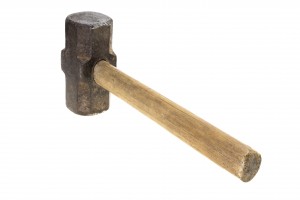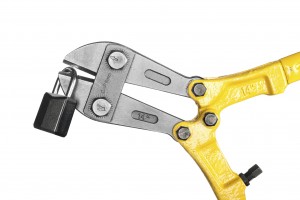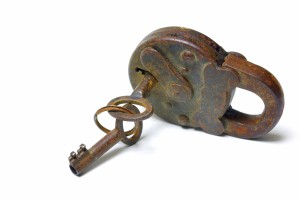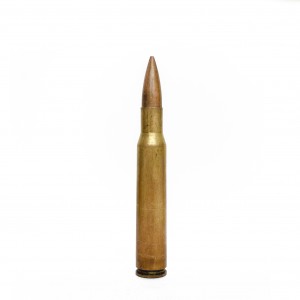For many people, padlocks are the default option when it comes to locking and securing things like:
- Sheds
- Toolboxes
- Banker’s boxes
- Lockers
That same padlock can be all the stands between your property and a would-be thief looking to get at it.
Padlocks (well, door locks in general) sometimes undergo some strange and punishing tests before they make it to you.
Here’s just a few of them.
 1. The sledgehammer test
1. The sledgehammer test
Padlock vs. brute force.
This test is pretty straightforward: Take a sledgehammer, slam it against a security lock as hard as possible and see what happens.
Now, if you don’t happen to have a sledgehammer handy, another version of this test is to simply drop a set weight from a set height onto the lock.
Any padlock could break apart after multiple blows from a sledgehammer.
What you don’t want is a lock that’ll be useless after one or two shots.
You want something that’ll stand up to – and tire out – the most determined burglars.
 2. The bolt cutter test
2. The bolt cutter test
Bolt cutters are a burglar’s best friend and a padlock’s worst enemy.
Like the sledgehammer test, any home or commercial lock can snap if the bolt cutters (or rather, the person using them) apply enough pressure to it.
Therefore, the question is: what constitutes enough pressure? Well here are some fun PSI numbers:
- 90 PSI to crack an egg on its side
- 300 PSI to crush a full can of beer
- 950 PSI to crack a LEGO brick
- 3700 PSI in an alligator bite
- 80,000 PSI to crush a car
For padlocks, the higher its PSI tolerance level, the better.
High-end padlocks should be able to easily withstand over 250 PSI of pressure.
3. The tensile test
This test measures how much force it takes to pull the shackle (the curved, “U”-shaped part of the lock) from the cylinder.
Now, no burglar on Earth should be strong enough to pull apart a lock with their bare hands (and if they are, well, that’s another problem altogether).
In order to perform a tensile test, a special tensile testing machine is required.
On average, poor lock hardware will pull apart at just 1000 lbs of pressure. The strongest padlocks can handle over 3000 lbs of tensile pressure.
 4. The weather test
4. The weather test
Many padlocks are left outside for an extended period of time in all weather conditions, like the ones we experience in Milton, where Aim Lock & Safe Ltd is located.
But are they able to handle it?
The weather test involves taking the lock and putting inside a chamber that mimics nasty weather situations like:
- Extreme cold
- Wind
- Rain
- Acid rain (yikes!)
- Fog
- Hail and salt exposure
Oh, and the poor padlocks stay in this special chamber for a week.
When they come out, they’re tested to see if they’re functional (some locks may be permanently stuck shut).
In some cases, the security lock hardware may look in rough shape, but they still work as expected.
 5. The gunshot test
5. The gunshot test
How many times have you seen this in the movies?
There’s a stubborn lock and, with no other way to open it, the bad guy takes a gun and shoots it.
That Hollywood magic comes to life in the testing labs of padlock manufacturers.
Here’s how they do it:
- Pick a gun
- Pick a distance
- Shoot the lock
- See what happens
Some bullets will pass through the lock, but leave it unlatched. Other will damage the lock enough to pry it open by hand.
And some bulletproof locks are just that.
We’ve got the toughest locks around
Testing padlocks can be fun.
But the reliability of your locks & hardware is no laughing matter.
If you think you’ve got old or unreliable locks, we can help in a variety of ways:
- Book a security consultation: We’ll come to you and inspect your locks, doors and security systems.
- Contact our 24/7 mobile locksmith: Get instant lock repairs or replacements on-site as soon as you need them.
- Ask a locksmith: Got a question? Want to know more about our products or services? Just tell us and we’ll get back to you with the answers you need.







